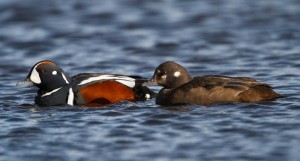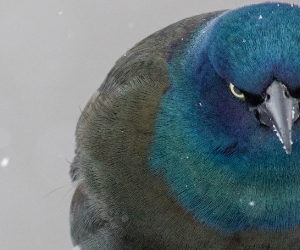Species Spotlight: Harlequin Duck
Get to know some of the species at risk in the Lac Deschenes Ottawa River IBA with the Species Spotlight, aka
“Sp-Spot.” Today meet the: Harlequin Duck.

Male and Female Harleguin Duck
Photographer Omar Runolfsson
Scientific Name: Histrionicus histrionicus
SARA status: Endangered; Quebec: Vulnerable
Taxonomic Group: Birds
Size: 33-54 cm in size, with a wingspan of
56-66 cm. On average, males weigh less than 700 g and females weigh less than 600 g
Bold colour patterns make the Harlequin Duck very recognizable. The males are easy to spot due to their dark bodies, reddish brown under parts, streaks of white on the body and head, and blue accents. Unlike the males, the females are a plain brown-grey colour with patches of white around the eye.
Look for the Harlequin Duck in coastal marine environments during most parts of the year. They move inland in the spring in search of fast flowing rivers where they breed and build their nests on the banks. The Harlequin Duck will dive to the bottom of freshwater stream beds to forage for insects, fish, and marine invertebrates. Due to this type of habitat, the Harlequin Duck is very sensitive to fluctuations in water levels and food suppy.
According to the State of the Worlds Bird Report recently released by BirdLife International, duck populations are rebounding overall thanks to conservation efforts. The Harlequin Duck, like other duck populations, has benefited from stricter hunting regulations. Although hunting of the Harlequin Ducks has not been permitted in recent years, they are extremely vulnerable to hunters because of their tameness, their tendency to feed close to shore, and the female’s resemblance to other species that may be legally hunted. These ducks also have a low reproductive rate which makes it more challenging for populations to recover after suffering a decline.
Where Else Can You See This Species?
There are populations of Harlequin Ducks found along the West and East coasts of Canada and another population in New England. Currently, there are less than 2000 Harlequin Ducks in eastern Canada. Small groups have been located in the Gaspé Peninsula and Québec’s Anticosti Island, and a few individuals may spend the winter in Prince Edward Island. In the winter, Harlequin Ducks are most often seen at the Deschénes rapids and the Remic rapids along the Ottawa River.
Did You Know?
- Their nests can be found at the ledge of rock cliffs, sometimes as high as 20 meters above the water.
- The Harlequin Duck gets its name from the bold patterns and decorated appearance of the male, which resembles the costumes worn by “harlequins” who were a type of clown or comic servant.
Check back every week to read about a different species at risk that can be found in Lac Deschênes.
You can report sightings of this and other rare species to the Canadian Wildlife Service at (819) 997-2800 or on the MNR Natural Heritage Information Centre website. A photo and the location of your sighting are also very helpful!
We would like to thank Alicia Cuzner for this post. Alicia is a conservation intern for Nature Canada and she will be focusing on the Lac Deschenes Ottawa River Important Bird Area project during the summer. She is interested in sustainability, the environment, and education.




